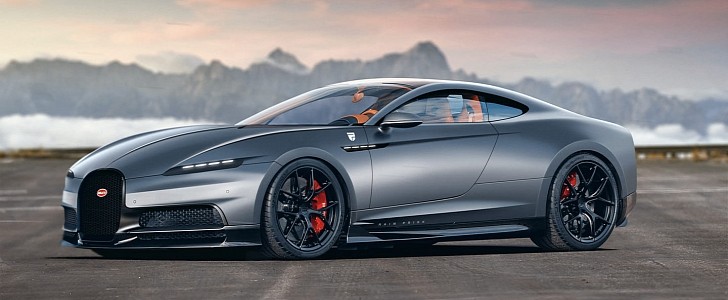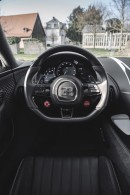Often mistaken for an Italian company, Bugatti was founded by Ettore Bugatti in the French city of Molsheim when the Alsace region was a part of the German Empire. Unfortunately, World War II left the historic factory in ruins, and the original incarnation of the luxury automaker ceased to exist in 1952.
Multiple companies attempted to revive Bugatti in the 1960s and 1970s, but as fate would have it, business magnate Romano Artioli was the man who finally managed to resurrect the brand. The EB 110 produced in Modena, Italy, of all places, laid the groundwork for the Veyron and Chiron of today.
Throughout its existence, Bugatti rolled out a lot more front-engined models than mid-engine hypercars. That brings us to pixel artist Rain Prisk who imagined the Chiron with very different proportions from the real deal.
More or less the sprong of a Bugatti and a V8 Vantage, the Aston Martin-inspired grand tourer looks particularly menacing with matte-black paint. The design study also sweetens the deal with Bugatti-branded calipers, Michelin rubber wrapped around twin-spoke wheels finished in gloss black, and four extremely thin light-emitting diodes on each door and front fender.
As to what kind of engine hides under the hood, we can only speculate. The quad-turbo W16 from the Chiron is unlikely for many reasons, including the packaging and transaxle dual-clutch transmission. Developed by Ricardo, the heavy-duty transmission alone costs more than two C8 Corvettes.
A more likely candidate for propulsion would be the force-fed V8 found in the Porsche Panamera and more exotic models from the Volkswagen Group, including the Lamborghini Urus. The problem with this engine is that Bentley uses it in the Continental GT, which is based on the Panamera’s platform. The in-group synergy would obviously dilute Bugatti, which is why the 4.0-liter V8 powerplant doesn’t actually befit a Bugatti product.
Back in the real world, the company is more focused on the successor of the Chiron at the present moment. But going forward, Bugatti may transition to electric vehicles because Porsche and Rimac are in talks for a joint venture.
Throughout its existence, Bugatti rolled out a lot more front-engined models than mid-engine hypercars. That brings us to pixel artist Rain Prisk who imagined the Chiron with very different proportions from the real deal.
More or less the sprong of a Bugatti and a V8 Vantage, the Aston Martin-inspired grand tourer looks particularly menacing with matte-black paint. The design study also sweetens the deal with Bugatti-branded calipers, Michelin rubber wrapped around twin-spoke wheels finished in gloss black, and four extremely thin light-emitting diodes on each door and front fender.
As to what kind of engine hides under the hood, we can only speculate. The quad-turbo W16 from the Chiron is unlikely for many reasons, including the packaging and transaxle dual-clutch transmission. Developed by Ricardo, the heavy-duty transmission alone costs more than two C8 Corvettes.
A more likely candidate for propulsion would be the force-fed V8 found in the Porsche Panamera and more exotic models from the Volkswagen Group, including the Lamborghini Urus. The problem with this engine is that Bentley uses it in the Continental GT, which is based on the Panamera’s platform. The in-group synergy would obviously dilute Bugatti, which is why the 4.0-liter V8 powerplant doesn’t actually befit a Bugatti product.
Back in the real world, the company is more focused on the successor of the Chiron at the present moment. But going forward, Bugatti may transition to electric vehicles because Porsche and Rimac are in talks for a joint venture.


















